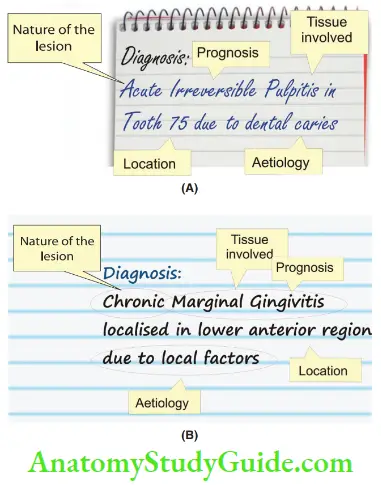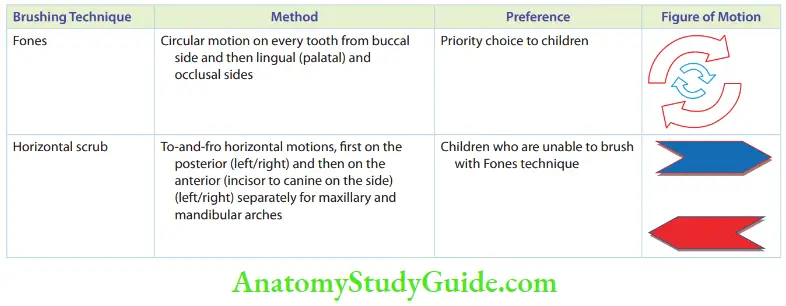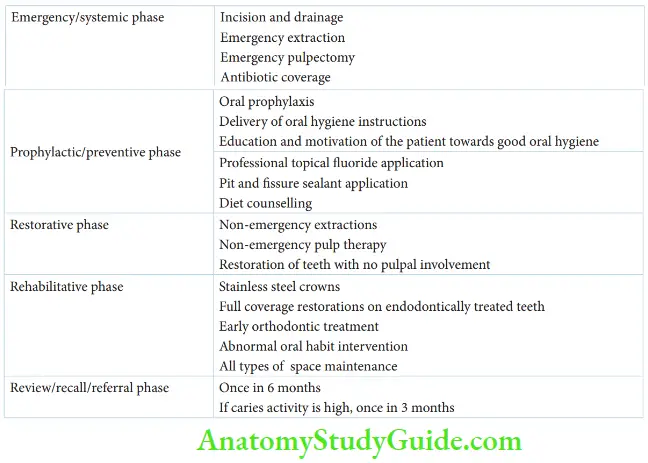Diagnosis And Treatment Planning Introduction
Elaborate history and thorough clinical examination lead to a diagnosis. Such a diagnosis made without the required investigations is a provisional diagnosis. Indicating relevant investigations and the results obtained helps in arriving at a confirmatory diagnosis.
Table of Contents
The confirmatory or final diagnosis has to be expressed in a strategic ‘sentence frame’. An elucidated diagnosis can help in formulating the treatment plan. A fully written diagnosis should carry in itself the following:
Read And Learn More: Paediatric Dentistry Notes

- Tissue that is involved – soft tissue/hard tissue and the name of the tissue
- Nature of the lesion – acute/chronic
- Prognosis of the lesion – reversible nature/ irreversible nature
- The location of the disease – on/around which tooth
- Etiology – etiology/causative factors of the disease and elucidated time of occurrence
A proper diagnosis is elaborate and complete. It contains significant findings and a compounded etiology
- Significant findings: For example, chronic dentoalveolar abscess in relation to tooth 75 with extraoral draining sinus and submandibular lymphadenopathy due to dental caries
- Compounded etiology: For example, chronic marginal gingivitis generalized due to an exfoliating tooth and an erupting malpositioned tooth, and associated poor oral hygiene
A well-framed diagnosis also mentions the prognosis (reversible/irreversible, the nature of the disease) of the condition that throws light on treatment planning.
Phases Of Treatment Planning
Meticulous treatment planning is done in five phases, as follows:
- Emergency phase
- Prophylactic phase
- Restorative phase
- Rehabilitative phase
- Review and recall phase
- Emergency Phase/Systemic Phase Any treatment that is advised to allay pain or stop the spreading of dentoalveolar infection is called emergency treatment. The different modes of treatment done in the emergency phase are listed in Table. A child suffering from a chronic systemic illness or under continuous medication has to be referred to the physician to obtain consent regarding the fitness for dental treatment procedures under local/general anesthesia. The physician may also be requested to comment on altering specific drug dosages. Any precautions to be taken during the dental procedure or any other points of special mention have to be taken into consideration. The physician’s advice should be strictly adhered to during the dental treatment. For instance, the physician may advise the use of lignocaine without adrenaline for a hyperthyroid child. This is because adrenaline can lead to arrhythmia in the hyperthyroid child as thyroxine sensitizes the myocardium to catecholamines (adrenaline).

- Prophylactic/Preventive Phase The objective of the prophylactic phase is to upkeep the general condition of the oral cavity. It includes oral prophylaxis procedures such as supragingival and subgingival scaling and polishing. Apart from this, the patient is educated and motivated towards good oral hygiene. The right brushing technique, that is, the Fones or horizontal scrub technique, is taught to the patient.

- The preventive phase consists of the following:
- Professional topical fluoride application
- Pit and fissure sealant application
- Diet counselingThe extent of preventive procedures advised will be based on the caries activity tests conducted during investigations.
- Restorative Phase The restorative phase constitutes all treatment procedures done to restore the integrity of the dental arch. The phase includes the following:
- Non-emergency extractions
- Non-emergency pulp therapy
- Restoration of teeth with no pulpal involvement
- Non-salvageable teeth have to be extracted before the integrity of the arch can be restored. This is the reason for listing extractions of hopelessly decayed or traumatized teeth with poor storability (pulpectomy cannot be performed) under the restorative phase.
- Rehabilitative Phase Rehabilitation of the lost integrity of the arch is the focus of this phase. This phase comprises treatment modalities, which are as follows:
- Stainless steel crowns
- Full-coverage restorations on endodontically treated teeth
- Early orthodontic treatment
- Abnormal oral habit intervention
- All types of space maintenance
- Review, Recall, And Referral Phase When all the dental treatment is complete, the child requires a regular dental review every 6 months. The objective of the review is to assess the caries activity. If caries activity is very high, a review is required every 3 months. At each review, the teeth are examined for new lesions. Preventive care is emphasized and the child is motivated towards good tooth brushing.
Sometimes, children may be kept on shorter recall appointments such as every 2 weeks or 6 weeks to assess exfoliating teeth, apexification or to gauge the outcome of an indirect pulp capping.
Although minor correction in malocclusion of teeth with removable or fixed mechanotherapy can be done at the pediatric dental clinic, older children who require comprehensive orthodontic treatment with extraction of premolars will have to be referred to an orthodontist.
This is called a ‘referral’. The treatment plan schedule, once established, has to be adhered to during the delivery of dental care. This ensures the delivery of logical, systematic, effective, and efficient dental care.
Diagnosis And Treatment Planning Summary
- The frame of a complete diagnosis should include the following:
- Tissue that is involved
- Nature of the lesion (acute/chronic)
- Prognosis of the lesion
- Location of the disease
- Aetiology (elucidate the time of occurrence)
- Treatment planning encompasses five phases, which are as follows:

Leave a Reply